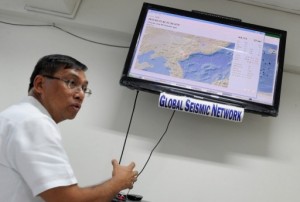COTABATO CITY, Philippines—The Philippine Institute of Volcanology and Seismology is sending scientists to North Cotabato to study and document previously unidentified fault line that goes through the provinces of North Cotabato and Sultan Kudarat.
Renato Solidum, Phivolcs chief, said it was this new fault line that caused last weekend’s earthquakes —about 400 have since been recorded, some too feeble to be felt— in Makilala and Kidapawan City in North Cotabato and Columbio in Sultan Kudarat.
From September 20 to September 22 alone, 80 earthquakes with magnitudes of up to 5.2, struck the area and caused damage, Solidum said.
The exact date of the arrival of the team in North Cotabato has yet to be set.
Mayor Rudy Caoagdan of Makilala, where the strongest earthquake took place, said at least 155 houses were destroyed and 208 families or 1,040 individuals had been affected.
Among the damaged structures were a chapel and a barangay hall in the village of Luayon, he said.
Caoagdan said minor damage was also reported in the villages of Bato, Malungon, Guangan, Villaflores and Sto. Nino. Four persons were reported injured, including a four-year-old girl.
Solidum said the tremors were triggered by tectonic activity, or the movement of huge plates underneath the surface.
The fault line “was not known before, only now that a series of earthquake occurred,” he said.
Hermes Daquipa, head of the Phivolcs office in Kidapawan, said they will study why the fault has suddenly become active.
He said the discovery of the fault should also put to rest speculation that the earthquakes were triggered by volcanic activity, particularly in Mt. Apo.
Mt. Apo is a dormant stratovolcano, whose last eruption has not been determined. But being stratovolcano, it was formed by layers of hardened lava from previous eruptions.
RELATED STORY
Central Mindanao quakes topple, damage over 50 houses
